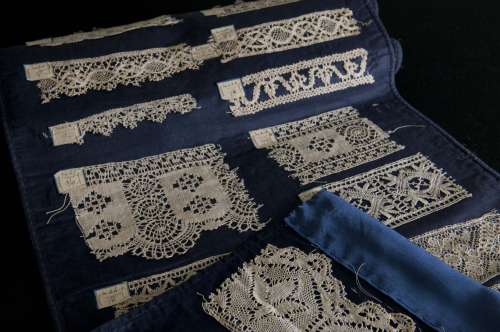
Unravelling the story behind lace

Museum objects can be simple, complex, rare and fascinating but standing on their own without any contextualisation they are merely an object. What makes an item unique is its history and story, sometimes unraveled slowly over time. Amongst the Hawke’s Bay Museums Trust collection is an eclectic group of items the Webb family brought with them when they emigrated from England to Ormondville, Southern Hawke’s Bay and of particular significance is a beautiful hand-made lace sampler.
In 1996, lace expert Pamela Nottingham from England visited here, having been notified about the sampler by Joan Maclaurin, a highly accomplished lace maker and Honorary Curator of Textiles at Hawke’s Bay Art Gallery & Museum (now MTG Hawke’s Bay). Pamela came specifically to research the sampler and, on close inspection, attributed it to the Winslow Lace Industry. This lace sampler comprises one hundred and twenty samples of lace individually stitched on a length of rich blue sateen fabric measuring 2.68 metres long. Each piece is numbered to match the Winslow Lace Industry pattern book, the price (per yard) and some include the lace maker’s initials.
During nineteenth century England, lace was created by women and girls to augment the household income, particularly the meagre earnings of farm labourers. Women and girls of all ages participated, often sitting outside in the sunshine to obtain adequate light and working long hours at the eye-straining task. From the ages of six or seven, girls from poor homes would be sent to lace school and, when proficient enough, their work was sold to lace dealers and this covered their tuition fees.
From the 1860s onwards the cottage industry had become increasingly uneconomic, partly because of the passing of an Act in 1870 by the Government advocating compulsory education for all children. This Act stopped children from being involved in the industry and had the follow-on impact of lace making skills not being passed onto future generations.
The Winslow Lace Industry was established in 1875 by Rose and Lucy Hubbard in the town of Winslow, Buckinghamshire, England – mainly to keep lace making viable as an occupation for women living under straitened circumstances. Rose and Lucy’s parents were Lord and Lady Addington (John and Maria Hubbard). Lady Maria was a firm supporter of lace makers and their craft, and it was from her that her daughters acquired their life-time interest. While Lucy entered a convent to become a nun in 1878, Rose remained at the Winslow Lace Industry’s helm until it closed 50 years later.
Set-up as a non-profit organisation, the Winslow Lace Factory sold goods directly to the customer, ensuring the lace makers received as much money as possible for their work. The company progressively marketed lace – sending pattern books out by mail and showing samples stitched onto fabric, from which the prospective buyer would make their selection. In 1908 the totally self-supporting Winslow Lace Industry, proudly announced in a pamphlet that during the previous two years they were the recipient of over 84 exhibition awards for the intricacy and high standard of lace and needlework crafted.
By the 1910’s however there only seventy lace makers affiliated to Winslow and this number continually decreased until, in 1925, the organisation closed, as their lace makers had either died or were too infirm to continue.
How did such a historically significant and unique English sampler end-up belonging to the Webb family and why was it packed carefully into their luggage and carried by ship for over 12,000 miles (19,312 kilometres) to far-distant Aotearoa New Zealand?
It must have meant a great deal to the family as they only had a limited amount of space on board ship. During Pamela’s research she discovered that the sampler had been assembled for Louisa, wife of Reverend David Greig, Vicar of Addington, South London. Lady Maria and Louisa were close friends and, in 1885, when the Greigs moved to Cottenham, a village north of Cambridge, it was probable that Louisa was given the sampler so that she could advertise the Winslow Lace Industry and assist by taking orders. In 1904, Edmundson Webb married Louisa’s daughter Lily, and they had two daughters, one of whom was Elizabeth Webb, who ultimately donated the sampler to the museum in 1991.
Published in the Hawke’s Bay Today newspaper on 15 April 2023 and written by Gail Pope, Social History Curator at MTG Hawke’s Bay.
Image: Hand-made lace sampler, 1885, Winslow Lace Industry
17 April 2023



